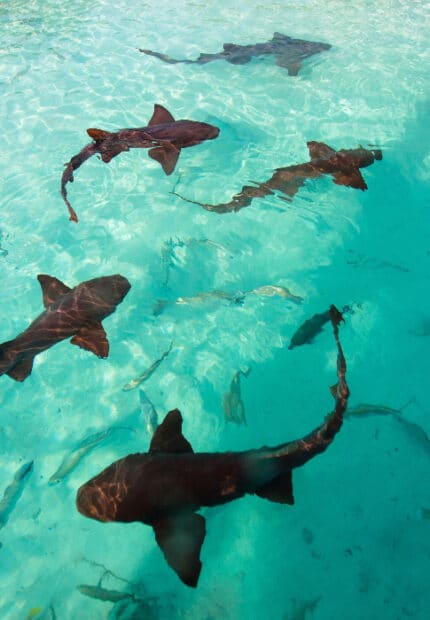
Is swimming with whale sharks ethical in Mexico?
Swimming with whale sharks is a dream for many ocean enthusiasts. But in recent years, overtourism at popular whale shark gathering sites, such as Isla Holbox in Mexico, has raised concerns about the impact of tourists on these gentle giants. Here, I (a real-life conservation biologist) will delve into the big question: is swimming with whale sharks ethical in Mexico?
Isla Holbox, located off the northern coast of the Yucatán Peninsula in Mexico, is a pristine island paradise. With powdery white sand beaches and crystal-clear turquoise waters, Isla Holbox offers a tranquil escape from mainland Mexico.
The island is also a very popular destination to swim with whale sharks. These gentle giants migrate to the waters surrounding Holbox at the same time each year. Seeing a whale shark in its natural habitat lets people appreciate the beauty of these animals. It also creates a connection to nature, and a deeper understanding of marine conservation.
However, as one of the planet’s more accessible ‘big wildlife’ encounters, more people are joining whale shark tours every year. There’s a risk that our desire for close-up encounters may end up doing more harm than good. And despite Mexico being more progressive in its whale shark conservation than other countries, it’s difficult to argue that this is a truly ethical wildlife experience. Keep reading to find out why we chose not to swim with whale sharks on Isla Holbox.
Jump to:
- What are whale sharks?
- When is whale shark season in Mexico?
- Why we chose not to swim with whale sharks in Isla Holbox, Mexico.
- What are the problems with whale shark tourism?
- What is Mexico doing to protect its whale sharks?
- Can whale shark tourism ever be ethical?
- Top tips for swimming with whale sharks responsibly
- Would we recommend swimming with whale sharks on Isla Holbox?
- FAQs
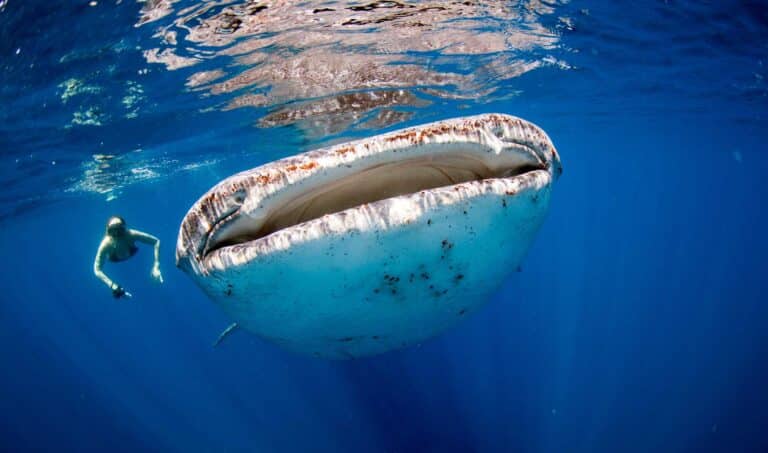
WHAT ARE WHALE SHARKS?
Well firstly, whale sharks aren’t actually sharks at all. Whale sharks (Latin name: Rhincodon typus) are actually the world’s largest living fish; they can grow to over twelve metres long, live up to 100 years, and weigh over ten tons! These charismatic creatures are filter-feeding fish, which means they spend most of their time in the open ocean, mouths open to hoover up plankton and smaller fish.
Like us, whale sharks prefer to hang out the warmer oceans of the planet’s tropical and warm-temperate areas. You can find them swimming near the coasts of Indonesia and the Maldives, and from the waters off Australia all the way to Mozambique and Mexico.
At certain times of the year, they gather together in large groups in coastal areas. Whale sharks move long distances to get to areas with the right water temperature that are experiencing localised blooms of planktonic organisms – their favourite food! These gatherings, known as aggregations, are usually the best time to see whale sharks in the wild, and they happen reliably every summer off the coast of Mexico.
WHEN IS WHALE SHARK SEASON IN MEXICO?
Whale sharks aggregate by the hundreds in a summer feeding area off the northeastern Yucatan Peninsula, Mexico, where the Gulf of Mexico meets the Caribbean Sea. This happens reliably every year between May – September, July being the peak month for sightings. This aggregation is the largest currently known to science!
It’s also the largest aggregation of whale shark tourists.
These gentle giants, which are docile and can spend hours a day near the water’s surface, attract thousands of tourists who not only come to observe them, but also to swim with them. Whilst some whale shark tourists do follow the rules and practice ethical wildlife tourism, a lot of them don’t! Here’s a quick video to summarise the problems with overtourism at Mexico’s whale shark sites.
Watch this two-minute video to understand the problems with whale shark tourism in Mexico!
IS SWIMMING WITH WHALE SHARKS ETHICAL AND RESPONSIBLE TOURISM?
Wildlife tourism needs to be ethical and sustainable. Ethical tourism is something of a buzzword these days. It basically means ‘thinking about the consequences of your actions as a tourist on the environment, local people and local economy’. In this situation, it means taking responsibility to protect the ocean and the whale sharks you’re hoping to see.
Do a quick Google search, and you’ll find tons of companies offering ‘ethical whale shark tours’. There are equally as many travel bloggers claiming that the tours that they took were wildlife friendly.
And while Mexico is doing more than most countries to regulate whale shark tourism (more on that later), it still didn’t sit right with us.
WHY WE CHOSE NOT TO SWIM WITH WHALE SHARKS ON ISLA HOLBOX
Doing our research, it wasn’t totally transparent which companies were practicing ethical and sustainable wildlife tours and which, well, weren’t. We found it difficult to glean any real information about companies on Isla Holbox that were particularly sustainable and there was no evidence that those who claimed they were following good practices actually were!
Additionally, many of the blogs we’d read that recommended specific companies as being ‘ethical’ and ‘whale-shark friendly’ had earned a couple of free places on the tour in exchange for a review. Now I’m not saying that these articles are automatically biased. But there’s a reason we pay for everything ourselves. We believe that it’s important to share our honest opinions. We can’t do that if we’re feel pressured to put a positive spin on experiences we’ve been ‘gifted’.
We’d spoken to other travellers between Panama and Mexico who described their whale shark tours in Mexico as ‘unethical’. We’d heard from several people how they’d booked onto a relatively expensive ‘ethical’ tour, only to find out they were being taken by another company that didn’t have a focus on responsible tourism. After stories of ‘dozens of boats chasing the whale sharks’ and descriptions of how boats had been seen bumping into them, we decided to give it a miss.
In the end, it just didn’t feel right for us.
BUT ALICE, DON'T YOU DIVE?
Yes, I do. But (to me at least!) there’s a difference between jumping into the ocean with four or five other divers with the hope of seeing something cool, and actively heading out to chase whale sharks at the same time as gosh-knows-how-many other boats.
I think whale sharks are amazing. They’re one of my favourite animals. If I’m lucky enough to come across one in the ocean when I’m not expecting it, I’ll be telling absoutely everyone who’ll listen. But, I care about whale sharks enough to not participate in unethical or controversial tourism that could harm them.
As usual, we recommend that you do your own research and form your own opinion. We hope that this blog will be a good starting point for you. Keep reading to learn more about why whale shark tourism can be harmful, what Mexico is doing to protect its whale sharks, and our top tips if you do decide to go swim with the whale sharks in Isla Holbox, or anywhere else in the world!

WHAT’S WRONG WITH WHALE SHARK TOURISM IN MEXICO?
#1 OVERCROWDING
The popularity of Isla Holbox as a whale shark tourism destination has led to overcrowding in the surrounding waters. Whale sharks are predictable and easy to find, but that doesn’t mean that they want to be found. Too many boats and tourists can stress the whale sharks, especially if people get too close to the whale sharks or try to touch them. This pushes them away from the site, impacting their natural behaviour patterns.
#2 FEEDING DISRUPTION
Whale sharks aggregate every year in the warm, shallow waters off the Yucatan Peninsula. This area has annual zooplankton patches – a super nutritious food that young whale sharks need for fast growth!
The presence of too many boats and tourists can, again, push them away from this site. This disrupts their feeding patterns, impacts their food source and in a worst-case scenario, could lead to starvation.
#3 BOATS CAN INJURE THE WHALE SHARKS
We’d heard about boats bumping into whale sharks from other travellers. But we didn’t realise how frequently this happened until we jumped online to do some research.
This scientific study showed that ‘whale sharks in the [Yucatan Peninsula] area frequently showed wounds and scars consistent with injuries from boat propellers or hulls’. In many cases the fins were damaged or even missing. Whale sharks are a migratory species, swimming up to 8000 km a year. Damaging their fins could seriously inhibit their ability to migrate for feeding and mating.
Another study found that 25% of the whale sharks observed off Isla Holbox between 2005 and 2008 had wounds from boat collisions. In 2013, as many as 60% of the animals had bruises and cuts from boats. Mexico has been trying to encourage ethical whale shark tourism since 2009, but clearly this hasn’t had the impact they’d hoped!
#4 ENVIRONMENTAL IMPACT
Increased tourism, especially if it’s concentrated in one area, can lead to higher levels of pollution. On whale shark tours, problems include; petrol spills from boats, plastic waste going overboard, and pollutants from sunscreen and skincare products. This pollution can harm not only the whale sharks but also the entire marine ecosystem, affecting various marine species and habitats.
#5 ECONOMIC DEPENDENCY
Local communities in Isla Holbox may become overly dependent on whale shark tourism for their income, especially as other industries (such as fishing!) are drying up. This dependency can lead to overexploitation of whale sharks and their habitat. If too many people in the economy focus their income on whale sharks, the community becomes vulnerable to economic fluctuations related to tourism, as we all saw during the recent pandemic!
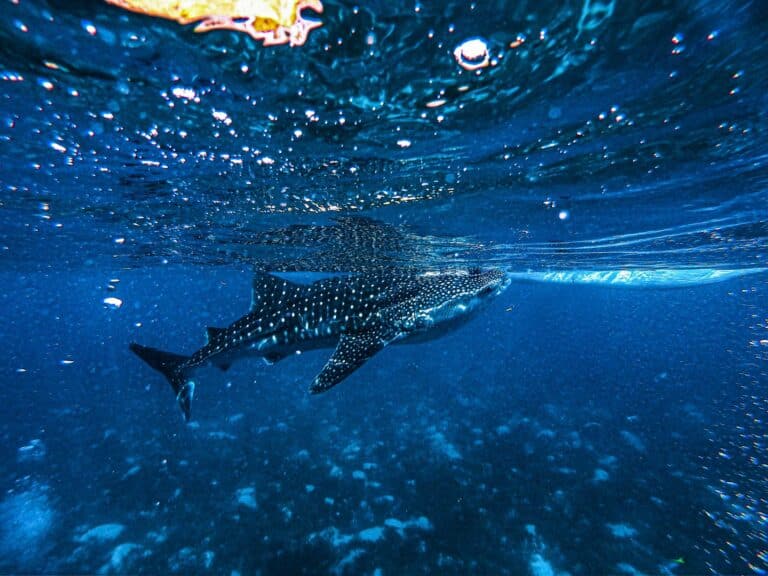
WHAT IS MEXICO DOING TO PROTECT ITS WHALE SHARKS?
Mexico is actually one of the countries doing the most to protect its whale sharks. The country has taken several measures to protect whale sharks and promote sustainable tourism practices in areas like Isla Holbox, including:
ESTABLISHING MARINE PROTECTED AREAS & SUPPORTING RESEARCH:
The Mexican government has established marine protected areas, such as the Whale Shark Biosphere Reserve in the waters surrounding Isla Holbox in attempt to conserve the natural habitats of whale sharks.
They support scientific research and collaborate with non-governmental organisations (NGOs) and international bodies to enhance conservation efforts. These partnerships often involve funding support, research collaboration, and the implementation of conservation projects.
IMPROVING REGULATIONS FOR WHALE SHARK TOURISM:
Mexico has also worked with conservation organisations and local fishermen to implement regulations for whale shark tourism operators, although no official laws actually exist. These ‘guidelines’ include going in small groups to areas where whale sharks aggregate, maintaining a safe distance from the animals, limiting the number of boats, and regulating the behaviour of tourists to minimise impact.
But, whilst each individual group may be small (usually less than 10 people per boat), this seems impossible with so many tour operators heading to the same spot. The boats from Isla Holbox and Isla Mujeres congregate at the same place at a very similar time of day, and tourists have described ‘dozens of boats chasing the whale sharks’. Clearly, these guidelines aren’t being implemented.
Since the guidelines were issued, business has boomed for the Yucatan’s whale shark tourism industry. Numbers have grown from just a few hundred tourists a year to over twelve-thousand annually. This puts more and more pressure on the whale shark population. Have the guidelines and regulations actually made this worse?
STRICTLY ENFORCING REGULATIONS
Mexico is also strictly enforcing its guidelines for whale shark tourism. Watch boats are a common sight at popular whale shark watching areas. Regular patrols monitor the sites to make sure that everyone is sticking to the rules and keeping a safe distance from the whale sharks.
However, as the industry has grown and more people have participated, these rules have become harder to moderate. There are more and more unlicensed operators popping up, and it can be difficult for well-meaning tourists to tell which companies are above-board and which aren’t. In peak season, Mexico also struggles to enforce its guidelines. With so many boats, and so much excitement (hello, there are WHALE SHARKS!?!) it can be difficult monitor everything all at once. Whale sharks continue to get pushed away from the site, or even injured, due to careless behaviour.
Although Mexico is trying, swimming with whale sharks in Isla Holbox is far from perfect. You’d definitely find it hard to classify it as eco-tourism. But can swimming with whale sharks ever be ethical?

CAN WHALE SHARK TOURISM EVER BE ETHICAL?
To feel a connection with and care about the environment, you need to experience it. Whether that’s witnessing a volcano erupt, watching baby turtles hatch, or swimming with a whale shark, feeling that sense of awe can leave an indelible mark. This pushes people to take action, and should be accessible. The more people who care, the better chance we have of protecting our planet and its inhabitants!
“An understanding of the natural world is a source of not only great curiosity, but great fulfilment.” – David Attenborough
We truly believe that whale shark tourism can be ethical. It’s been done in Australia after all! When done right, whale shark tourism represents an opportunity for local communities and conservation. Here are a few things we think Mexico (or you!) could do to improve!
#1 INCREASE EDUCATION
A better understanding of whale sharks can lead to more respect for these gentle giants in the Yucatan Peninsula.
There’s tons of information online, but during our trip to Isla Holbox, we saw very little information about how tourists should behave around whale sharks. There was one short video on the ferry over, but that was it! Holbox could do a better job of briefing tourists on proper conduct around whale sharks and other wildlife, including no touching, no chasing, and avoiding sudden movements and flash photography.
Educating and engaging local communities creates a sense of ownership. When local communities are involved and benefitting, they are more likely to actively participate in conservation efforts and discourage harmful practices. Their livelihood relies on the whale sharks coming back every year after all!
#2 LISTEN TO (AND BETTER ENFORCE) THE GUIDELINES
Whale shark tourism is fundamental to many island communities in Mexico and there are plenty of tour operators that respect the animals that underpin their industry and enforce rules to protect the whale sharks. But there are also many that don’t.
Ethical tourism should allow whale sharks to exhibit their natural behavior, which can’t happen if people get too close! Tours should emphasise maintaining a respectful distance from the whale sharks, but we read far too many blog posts about how this wasn’t explained or enforced. Boats should also keep a safe distance to keep from accidentally injuring a whale shark.
#3 FURTHER LIMIT THE NUMBER OF BOATS
Honestly, one of the best things we think Mexico could do is to further limit the number of boats and tourists allowed at each site each day. By enforcing permits, and spreading tourists around the Yucatan Peninsula, Mexico can ensure that the whale sharks are not overwhelmed by human presence.
This would make the experience more exclusive and probably more expensive as well. But similar schemes around the world, such as Ningaloo Reef in Australia, have shown that restricting access means that the stress and impact on the animals is reduced. The people who choose to visit put a higher value on being there, rather than choosing to swim with whale sharks because it’s the ‘thing to do’.

SWIMMING WITH WHALE SHARKS ETHICALLY AND RESPONSIBLY: OUR TOP TIPS
So, you’ve done your research and decided to swim with the whale sharks on Isla Holbox. But, of course, you want to do it responsibly. Whale shark tourism does pose a threat to whale sharks. Noisy tourists getting up close to the whale sharks can interrupt their feeding. Careless boats can damage fins and tails. We are the ones entering their habitat, so it’s important to minimise our impact.
Here are seven things you can do to be a responsible tourist around whale sharks:
#1 DO YOUR RESEARCH
Before you book your whale shark experience – it’s important to check that the swim is both ethical and environmentally sustainable. The only operator that we found and trust compeltely is a tour run by the World Wildlife Fund, based out of Isla Holbox.
We’ve heard so many bad things about tour operators in Cancun, Playa del Carmen and Isla Mujeres. Do your research! If you’re not sure whether an activity is ethical or not – you can always ask yourself:
- Is this activity harming the natural environment and/or wildlife?
- Am I supporting the local culture, or degrading it?
- Are my actions helping the economy or creating an unhealthy dependency on tourism?
- Is this tour operator caring for the environment or just focused on money?
#2 DON’T TOUCH THE WHALE SHARKS
Your guide should brief everyone about the importance of keeping a good distance, and most importantly, not touching the whale sharks. The area off the Yucatan Peninsula is the biggest whale shark feeding event of the year. Studies have shown how important these few months are for helping the smaller ones get important nutrients for faster growth.
You might think not touching or riding the whale sharks is common knowledge, but there are some surprisingly uneducated people on this planet. That’s why it’s important for tour operators to be the responsible ones and explain how best to appreciate whale sharks in their natural habitat.
#3 GIVE THE WHALE SHARKS SPACE
If you’re snorkelling with whale sharks, give them a wide berth! The guidelines recommend to stay at least five metres away to keep yourself, and the whale shark safe. Whale sharks weigh up to 26’000 kg, their tails and fins can whip around unpredictably, and their mouth has really strong suction (for all those plankton!). If you got in their way, you’d definitely come off worse for wear! Don’t worry, they’re massive, so you’ll get a really good view even if you stay a safe distance away.
#4 KEEP YOUR BOAT IN SIGHT
Mexican guidelines state that snorkelers can swim alongside whale sharks only in the presence of a licensed guide. Whale shark guides are there to increase your chances of seeing a whale shark, and make sure everyone has a good time when you do! ‘Everyone’ also includes the whale shark, which is why it’s so important to be respectful and follow the guidelines.
#5 DON’T WEAR SUNSCREEN
Caring for your skin is important. But if you’re going to snorkel with whale sharks, you need to stay clear of the sunscreen or make sure you choose reef safe sunscreen that’s 100% biodegradable! Coral reefs are dying, species are disappearing at an alarming rate, and whilst this isn’t entirely down to your choice of sunscreen, the chemicals in sunscreen are super hazardous to ocean wildlife.
You shouldn’t use any other oils or lotions either. Scientists say that environmental contaminants in your favourite skincare products might block the filters that whale sharks have for feeding.
There are lots of places in Central America that you’ll need to skip the sunscreen for. Governments in Central America prohibit the use of sunscreen, so if you plan to dive or snorkel at the Belize Barrier Reef, explore the Bay Islands in Honduras, swim or dive in Mexico’s cenotes, or simply enjoy the sun at Lake Bacalar, you might need an alternative!
But if you’re snorkelling without sunscreen, your butt can, and will, burn (I’m blonde and English, I know all about burning in the sun!). We recommend bringing a long-sleeved quick-dry t-shirt to cover up on the boat, and in the water. I’d also bring an old pair of sports leggings next time too.
#6 DON’T USE YOUR CAMERA FLASH
This applies to taking photos of any animal, whether that’s on land, in the ocean, or at a zoo/aquarium. Flash photography can disturb and scare away wildlife. So switch off the the flash on your phone before you pop it in its waterproof case, and make sure you know how to do it for any other equipment, such as your GoPro too.
#7 CONSIDER ALTERNATIVE WHALE SHARK HOTSPOTS?
Predictable aggregations of whale sharks have also been documented along the Belize Barrier Reef (April to May) and off the north shore of Utila, Honduras (February to May). Although these countries don’t have much in the way of whale shark regulations, there are significantly fewer tourists. This means you’ll be spreading your impact and reducing overtourism!
And, if you don’t see whale sharks, you are very likely to see nurse sharks, caribbean reef sharks, turtles, mantarays, dolphins and maybe even manatees! You don’t need to dive very deep for these: most of the wildlife around the Mesoamerican Barrier Reef can be seen with just a snorkel and set of fins.

Watch, don’t touch campaign poster (downloaded from WWF)
WHICH IS THE BEST WHALE SHARK TOUR IN ISLA HOLBOX?
We found it hard to find any reliable information about which is the best whale shark tour in Isla Holbox for an ethical wildlife experience. The only tour we’d feel 100% comfortable recommending is this one. It’s run by Natural Habitat Adventures in collaboration with the World Wildlife Fund, which are doing some great research to understand and conserve the whale sharks. It’s based out of Isla Holbox, so if you decide to swim with whale sharks, we’d recommend you check them out!.
SHOULD I SEE WHALE SHARKS IN ISLA MUJERES OR ISLA HOLBOX?
Tours setting off from Isla Mujeres and Isla Holbox will usually take you to the same sites. If you want to see or swim with whale sharks, you can set off from either of these islands. Just remember to check if your tour is responsible and really do your research for both islands.
We recommend that you avoid seeing whale sharks from Playa del Carmen. This city (which we didn’t vibe with at all) is notoriously bad for the lack of transparency when advertising whale shark tours. There are tons of accounts online of tourists booking a whale shark tour with an ‘ethical’ company in Playa del Carmen only to find out they’d been sold on to a cheaper company that didn’t care about the welfare of whale sharks at all.
SO, SHOULD YOU SWIM WITH WHALE SHARKS IN MEXICO?
To me, whale shark tourism in Mexico isn’t good enough yet, so we hesitate to fully recommend swimming with whale sharks in Mexico. Guide licensing and regulations on the number of boats and people allowed at any one time need to be tightened. Greater investment also needs to be made into enforcing these regulations.
That said, we also recommend you do your own research. If you find an ethical company and decide that a whale shark tour is right for you, we hope you have a great time (and maybe we’ll even be a little jealous!)
If you do choose to swim with the whale sharks in Isla Holbox, or elsewhere in Mexico, we’d love to hear about your experience! Drop us a comment below, particularly if you’d like to recommend a whale shark-friendly tour company (or one to stay well clear of!). You’ll be helping us, and other travellers, to make the best decision when embarking on ethical whale shark tours in the future.
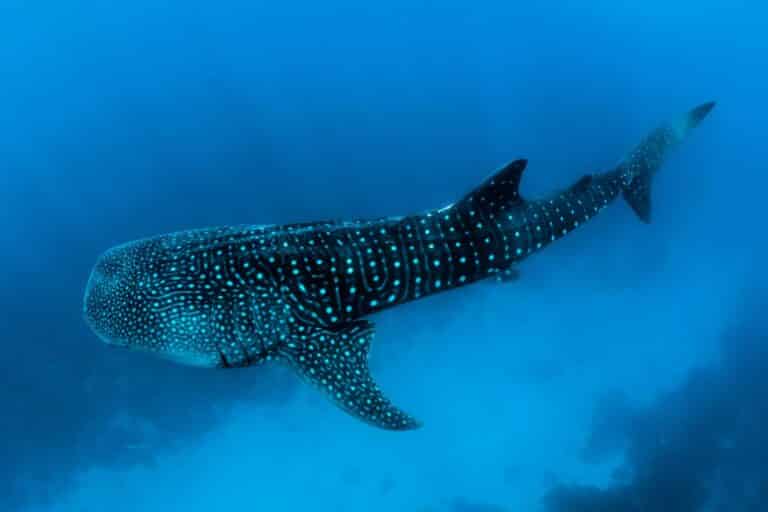
FAQs
Q: IS SWIMMING WITH WHALE SHARKS ETHICAL IN ISLA HOLBOX?
Well, that’s what we’ve outlined in this post! Swimming with whale sharks in Isla Holbox has the potential to be ethical and responsible tourism if practised responsibly and in alignment with conservation guidelines. Right now, we think it’s not quite up to scratch yet! You’d be hard pressed to classify whale shark tourism as ethical in Mexico at the moment.
Q: ARE WHALE SHARKS IN MEXICO?
Yes, whale sharks can be found in Mexico, specifically off the northeastern coast of Yucatan Peninsula, where the Gulf of Mexico meets the Caribbean Sea. This is one of the largest gatherings of whale sharks in the world.
Q: WHERE IN MEXICO CAN I SEE WHALE SHARKS?
Whale sharks migrate to the waters surrounding Isla Holbox and Isla Mujeres every year between May and September, with July being the peak month for sightings. You can set off from either of these islands to see if you can spot the whale sharks!
Q: WHEN DO WHALE SHARKS MIGRATE TO MEXICO?
Whale sharks migrate to Mexico, particularly the waters off the northeastern Yucatan Peninsula, between May and September each year. July is typically considered the peak month for whale shark sightings in Mexico
Q: WHY CAN’T YOU TOUCH A WHALE SHARK?
Touching the whale sharks can stress them out, affecting their behavior and potentially disrupting their feeding patterns. Human touch can also remove the protective mucus layer that covers their skin, making them vulnerable to infections and diseases. Respecting a safe distance and allowing these magnificent creatures to roam freely in their natural habitat ensures both their well-being and the safety of the humans observing them.
Q: ARE WHALE SHARKS DANGEROUS?
Whale sharks are not dangerous to humans. They are gentle filter-feeding creatures that primarily feed on plankton, small fish, and other microscopic organisms. However, it’s recommended to keep at least a five-metre distance. Whale sharks are huge and their fins can flap around a lot. You definitely wouldn’t want to get hit by one!
LIKE IT? PIN IT!
SAVE THIS POST TO YOUR MEXICO PIN BOARD TO INSPIRE YOUR TRAVELS
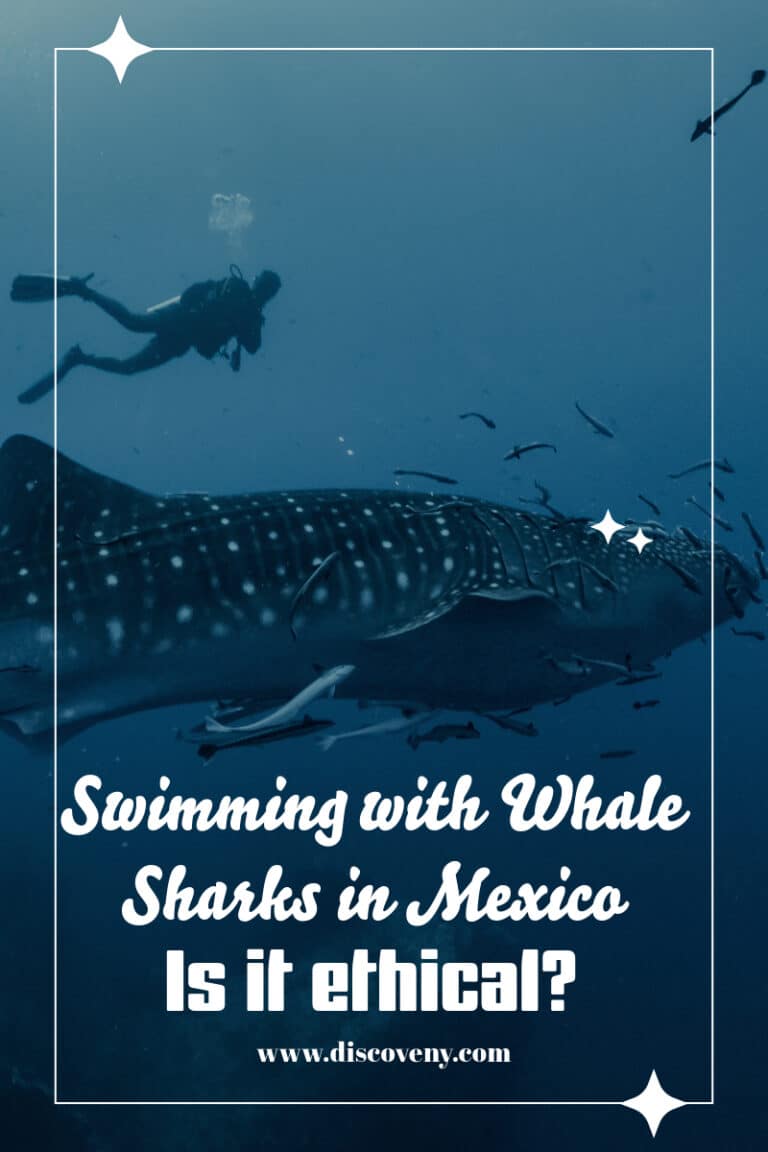

Follow our daily adventures on Facebook and Instagram
Disclaimer: The information and advice provided in this blog are the author’s opinions and based on their personal experiences. All information was accurate at the time of writing. However, things can change quickly, so always double-check current conditions and guidelines before setting out. Remember, your travels and safety are your own responsibility, and this blog can not be held responsible for anything that might happen on your adventures! Always exercise caution and good judgment. Oh, and don’t forget to get travel insurance! Happy travels!
This post may contain affiliate links (yay for transparency!) This means that I will earn a small commission, at no additional cost to you, if you click the link and choose to buy the product. I only link to stuff I have personally bought and found useful and never endorse crap. Your support helps keep the site going, thank you!
Alice
Alice is a UK travel blogger who advocates sustainable travel and being more eco-conscious on a budget. She loves coffee, her houseplants and summiting mountains.
You May Also Like
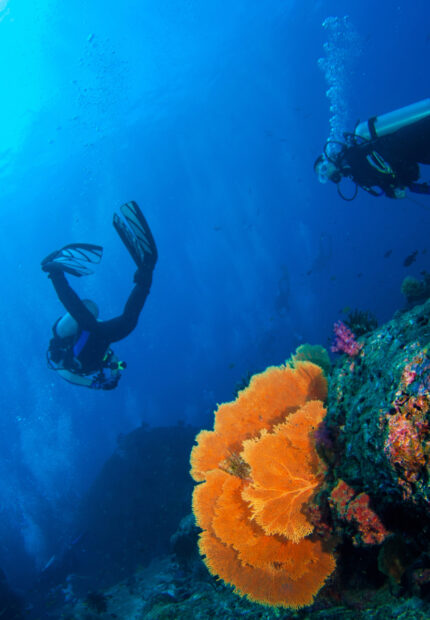
Getting your SCUBA diving Open Water Certification on a budget: the ULTIMATE guide for savvy travellers
August 17, 2024
The Ultimate Guide to Diving in Caye Caulker, Belize [2024]
April 27, 2024